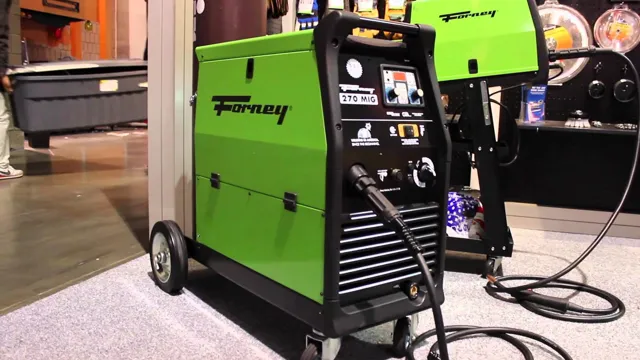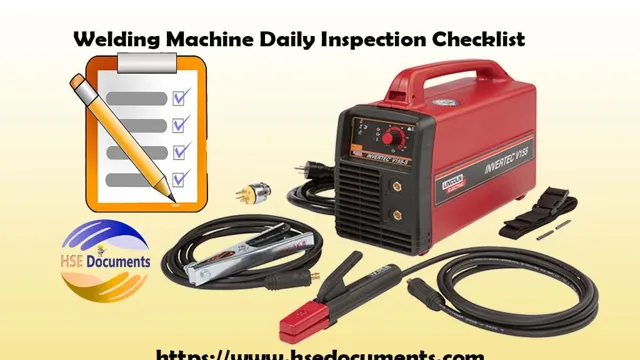Welding machines are a must-have tool in any metalworking industry. These machines are used to join two or more metal parts, ensuring strength and durability. However, like any other machine, welding machines require regular maintenance and frequent checks to ensure optimal performance.
Knowing how to check your welding machine is crucial in identifying potential problems and fixing them before they cause any damage. In this blog post, we’ll walk you through some easy steps on how to check your welding machine and keep it in top-notch condition. So, buckle up, and let’s dive into the world of welding machines!
Introduction
If you’re a welder, you know the importance of having a properly functioning welding machine. It’s essential that you check your welding machine regularly to ensure that it’s safe to use and producing high-quality welds. One of the first things you should do is check the power source and make sure it’s plugged in and turned on.
Next, you should inspect the electrode holder, ground clamp, and cables for any signs of wear or damage. If everything looks good so far, you can move on to checking the settings on your welding machine. Make sure that the amperage, voltage, and wire feed speed are all set correctly for the type of welding you’ll be doing.
Finally, you’ll want to test the machine by making a few test welds on some scrap metal to see if everything is working properly. By following these steps, you can keep your welding machine in good condition and ensure that you’re producing high-quality welds every time you use it.
Why Check Your Welding Machine?
Welding Machine Introduction: Welding machines are essential tools in various industries that involve metal fabrication, construction, and manufacturing. They are designed to join two pieces of metal together by melting them and forming a strong bond. However, just like any other machinery, welding machines need to be checked regularly to ensure that they are functioning at their best.
Whether you are a professional welder or a DIY enthusiast, checking your welding machine regularly will help you produce high-quality welds, prevent accidents, and extend the lifespan of your equipment. In this blog post, we will discuss why it is important to check your welding machine and how you can do it. So, let’s get started!

What to Look for When Checking Your Welding Machine
When it comes to welding machines, it’s important to take the time to perform regular checks to ensure they are functioning properly. Over time, wear and tear can occur, and parts may need to be replaced. So, what should you look for when checking your welding machine? One of the most critical components to check is the welder’s power output.
A weak output can lead to poor weld quality, while an output that is too strong can result in material warping or even burn-through. You’ll also want to check the connections and wiring to make sure they are secure and not damaged. In addition, inspect the electrodes, as well as the welding gun, and look for signs of wear or damage.
Taking the time to regularly check your welding machine can help prevent accidents and maintain safety in the workplace, while also ensuring your equipment lasts for years to come.
Steps to Checking Your Welding Machine
If you’re looking to ensure that your welding machine is working properly, there are a few simple steps you can take. First, you’ll want to inspect the cables and connections to make sure they’re in good condition and securely attached. Next, check the power source – is it strong enough to support your machine? If not, you may need to upgrade it.
Then, you can perform a test weld on a scrap piece of metal to make sure the machine is producing the correct type of weld and that the weld is strong and even. Lastly, don’t forget about maintenance – regular cleaning and replacing any worn or damaged parts can help extend the life of your machine. By taking these steps, you can ensure that your welding machine is working properly and producing the best possible results for your projects.
Step 1: Inspect the Power Cord and Plug
If you want to check if your welding machine is working properly, there are a few basic steps to follow. First, take a look at the power cord and plug. Make sure there are no cuts, frays, or other damage to the cord, and that it’s firmly attached to the machine.
Check the plug for any signs of wear and tear, including loose prongs, cracks, or exposed wires. If you notice anything amiss, unplug the machine and replace the cord or plug before using it again. It’s also a good idea to inspect the outlet you’re using to power the machine, just to make sure it’s in good condition and providing a steady supply of electricity.
By starting with these basic checks, you can help ensure your welding machine is safe and ready to use.
Step 2: Check for Loose Connections
When it comes to maintaining your welding machine, checking for loose connections is an essential step in ensuring the longevity of your equipment. Loose connections can lead to poor performance, overheating, and even electrical hazards. To start, make sure your machine is turned off and unplugged.
Then, inspect all wires and cables for any signs of wear or damage. Next, check that all connectors are tightly secured and not corroded. It’s also important to examine the inside of your machine for any loose or disconnected components.
If you do find any loose connections, use a wrench or pliers to tighten them up. Properly securing all connections can help prevent future issues and extend the life of your welding machine.
Step 3: Inspect the Ground Clamp and Cable
When it comes to checking your welding machine, one important step is to inspect the ground clamp and cable. This is crucial for ensuring that there is a proper electrical connection between your machine and the metal that you’re welding. Start by checking the clamp itself to make sure that it’s securely attached to the cable.
If it’s loose or damaged, replace it right away. Next, inspect the cable for any signs of fraying or damage. This is important because if there is any damage to the cable, it could pose a safety risk during welding.
If you do see any damage, stop welding immediately and replace the cable before continuing. By taking the time to inspect your ground clamp and cable regularly, you can ensure that your welding machine is working safely and effectively, while also ensuring a high-quality weld every time.
Step 4: Check the Electrode Holder and Cable
As we continue with the steps to checking your welding machine, it’s important to check the electrode holder and cable. This piece of equipment is crucial for the transfer of electricity from the welding machine to the electrode. A simple inspection of the cable includes checking for any visible damage such as cuts, kinks or burns.
Any damage or corrosion in the electrode holder or cable can lead to poor conductivity and even worse, an electrical hazard. It’s also essential to make sure the electrode holder is clean and free from debris or splatter from previous welding sessions, as this can also impact the welding process. By taking a few minutes to inspect and maintain these parts, you can ensure that your welding machine is working at its best, and you can complete your welding work with ease and efficiency.
Step 5: Test the Unit’s Electrical Output
After following the previous steps of checking your welding machine, it is important to test its electrical output. To do this, you can use a multimeter to measure the voltage and amperage of your unit. Make sure to turn off the machine before making any measurements.
First, adjust your multimeter to the correct range. Then, place the red probe on the positive terminal and the black probe on the negative terminal. Turn on your machine and check the readout on your multimeter.
If your machine is working properly, the voltage and amperage should be within the range specified by the manufacturer. If the readings are outside of this range, it may indicate a problem with your machine. This could be due to a faulty transformer or rectifier, or a loose connection.
It is recommended to refer to your machine’s manual or seek professional assistance to diagnose and fix any issues. Regularly checking your welding machine’s electrical output can help ensure safety and prevent any potential damage or accidents.
Conclusion
In conclusion, checking a welding machine may seem intimidating at first, but it’s simply a matter of common sense and careful inspection. The key is to be thorough and diligent, and not to rush through the process. Remember, a well-maintained welding machine can be the difference between a successful project and a costly mistake.
So, don’t be afraid to ask for help, and always trust your instincts when it comes to the safety of yourself and others. With these tips in mind, you’ll be well on your way to becoming a skilled and confident welder in no time!”
Importance of Regular Welding Machine Checks
Regular welding machine checks are crucial to ensuring that your welding machine is functioning properly and producing high-quality welds. By following these simple steps, you can check your machine and catch any potential issues before they become major problems. The first step is to visually inspect your machine, looking for any signs of damage or wear and tear.
Next, check all of the connections and cables, making sure they are securely fastened and not frayed. You should also check the shielding gas flow, as any interruption or inconsistency could affect your weld quality. Finally, it’s important to test your machine’s electrical output, as incorrect voltage can cause poor welds or even damage your equipment.
By regularly checking your welding machine, you can ensure that your welds are strong, reliable, and of the highest quality.
FAQs
What are the common types of welding machines?
The common types of welding machines are TIG welding machines, MIG welding machines, Stick welding machines, and plasma arc welding machines.
What are the signs of welding machine malfunction?
The signs of welding machine malfunction are overheating, low or no output, improper electrode extrusion, or irregular arc.
How do I check the polarity of my welding machine?
To check the polarity of your welding machine, use a multimeter to measure the voltage between your electrode and your workpiece. If the reading is positive, the polarity is direct current electrode positive (DCEP), and if the reading is negative, the polarity is direct current electrode negative (DCEN).
How often should I calibrate my welding machine?
You should calibrate your welding machine at least once a year or as recommended by its manufacturer to ensure its accuracy and performance.
How can I improve the performance of my welding machine?
You can improve the performance of your welding machine by keeping it clean and well-maintained, using the correct welding technique, adjusting the welding settings correctly, and using high-quality welding consumables.
What safety precautions should I take when using a welding machine?
When using a welding machine, you should wear protective clothing, gloves, and eye protection, ensure proper ventilation, keep flammable materials away, and never touch the electrode or workpiece with bare skin or wet clothing.
What factors should I consider when buying a welding machine?
When buying a welding machine, you should consider the type of welding you will be doing, the thickness of the material to be welded, the welding technique you will be using, the power source, and the budget.






